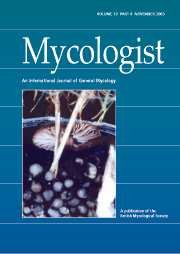Crossref Citations
This article has been cited by the following publications. This list is generated based on data provided by
Crossref.
2000.
21st Century Guidebook to Fungi.
p.
3.
2004.
Author's Response.
Journal of Forensic Sciences,
Vol. 49,
Issue. 5,
p.
JFS2004141.
Carter, David O.
Yellowlees, David
and
Tibbett, Mark
2006.
Cadaver decomposition in terrestrial ecosystems.
Naturwissenschaften,
Vol. 94,
Issue. 1,
p.
12.
Suzuki, Akira
2006.
Experimental and physiological ecology of ammonia fungi: studies using natural substrates and artificial media.
Mycoscience,
Vol. 47,
Issue. 1,
p.
3.
Boyle, Herbert
Zimdars, Bettina
Renker, Carsten
and
Buscot, François
2006.
A molecular phylogeny of Hebeloma species from Europe.
Mycological Research,
Vol. 110,
Issue. 4,
p.
369.
Carter, David
and
Tibbett, Mark
2008.
Soil Analysis in Forensic Taphonomy.
p.
29.
Hopkins, David
2008.
Soil Analysis in Forensic Taphonomy.
p.
53.
Menezes, Ritesh G.
Kanchan, Tanuj
Lobo, Stany W.
Jain, Animesh
Bhat, Nishanth B.
and
Rao, Nageshkumar G.
2008.
Cadaveric fungi: Not yet an established forensic tool.
Journal of Forensic and Legal Medicine,
Vol. 15,
Issue. 2,
p.
124.
Carter, David O.
and
Tibbett, Mark
2008.
Does repeated burial of skeletal muscle tissue (Ovis aries) in soil affect subsequent decomposition?.
Applied Soil Ecology,
Vol. 40,
Issue. 3,
p.
529.
Sagara, Naohiko
Yamanaka, Takashi
and
Tibbett, Mark
2008.
Soil Analysis in Forensic Taphonomy.
p.
67.
Suzuki, Akira
2009.
Propagation strategy of ammonia fungi.
Mycoscience,
Vol. 50,
Issue. 1,
p.
39.
Suzuki, Akira
2009.
Fungi from Different Environments.
p.
189.
Langejans, Geeske H.J.
2010.
Remains of the day-preservation of organic micro-residues on stone tools.
Journal of Archaeological Science,
Vol. 37,
Issue. 5,
p.
971.
Bristow, Joanne
Simms, Zoe
and
Randolph-Quinney, Patrick
2011.
Forensic Anthropology.
p.
279.
Raut, Jay Kant
Suzuki, Akira
and
Yoshihara, Megumi
2011.
Effects of environmental factors on basidiospore germination of ammonia fungi Coprinopsis spp. collected from different geographical areas.
Mycoscience,
Vol. 52,
Issue. 5,
p.
300.
Hawksworth, David L.
and
Wiltshire, Patricia E.J.
2011.
Forensic mycology: the use of fungi in criminal investigations.
Forensic Science International,
Vol. 206,
Issue. 1-3,
p.
1.
Caccianiga, Marco
Bottacin, Stefania
and
Cattaneo, Cristina
2012.
Vegetation Dynamics as a Tool for Detecting Clandestine Graves.
Journal of Forensic Sciences,
Vol. 57,
Issue. 4,
p.
983.
Martínez-Ramírez, Jorge A.
Voigt, Kerstin
and
Peters, Frank T.
2012.
Studies on the metabolism of five model drugs by fungi colonizing cadavers using LC-ESI-MS/MS and GC-MS analysis.
Analytical and Bioanalytical Chemistry,
Vol. 404,
Issue. 5,
p.
1339.
Martínez-Ramírez, Jorge A.
Strien, Juliane
Sanft, Juliane
Mall, Gita
Walther, Grit
and
Peters, Frank T.
2013.
Studies on drug metabolism by fungi colonizing decomposing human cadavers. Part I: DNA sequence-based identification of fungi isolated from postmortem material.
Analytical and Bioanalytical Chemistry,
Vol. 405,
Issue. 26,
p.
8443.
Stokes, Kathryn L.
Forbes, Shari L.
and
Tibbett, Mark
2013.
Human Versus Animal: Contrasting Decomposition Dynamics of Mammalian Analogues in Experimental Taphonomy.
Journal of Forensic Sciences,
Vol. 58,
Issue. 3,
p.
583.




